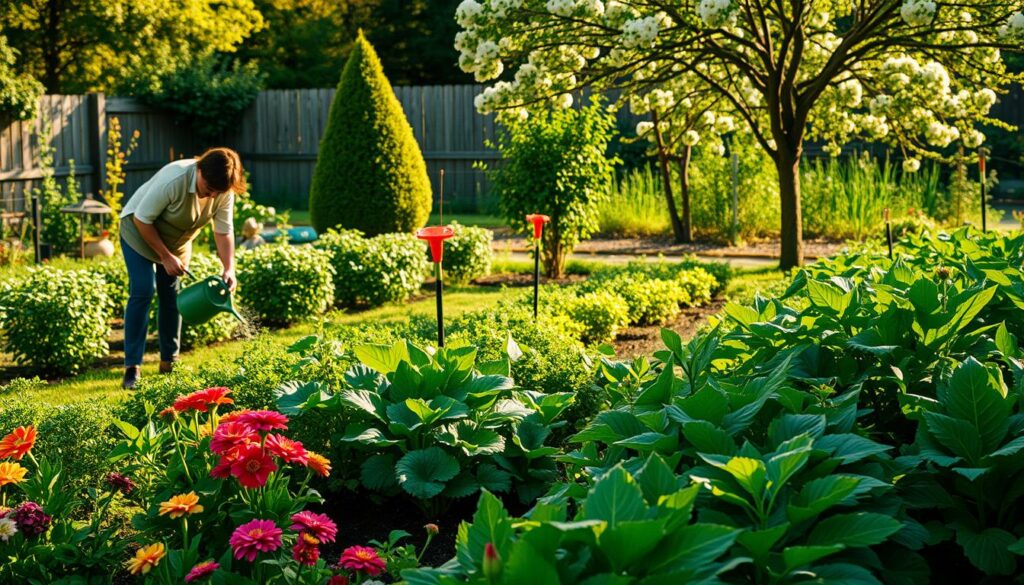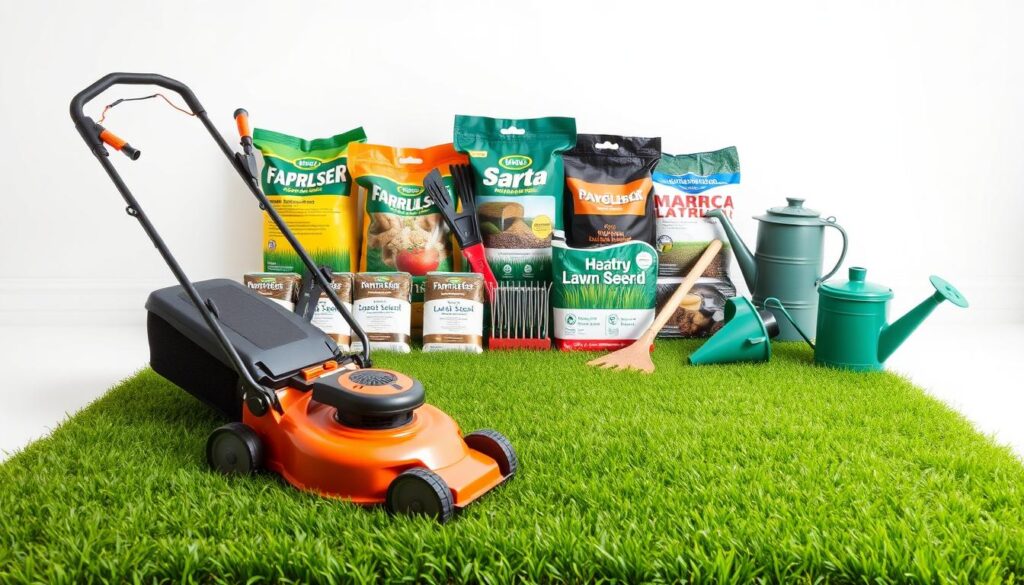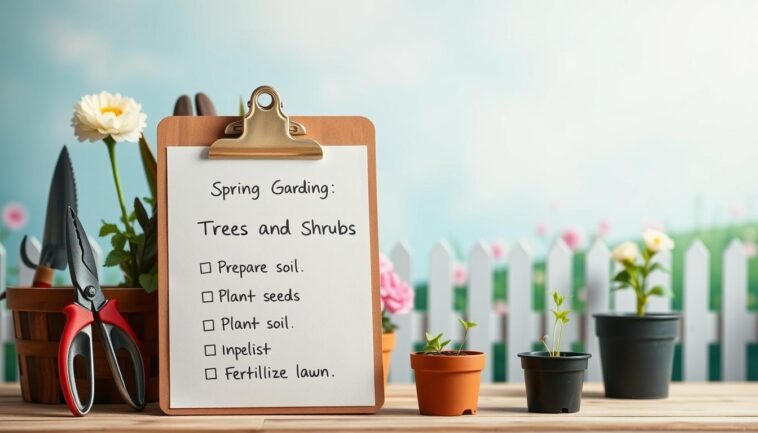Preparing my garden for spring is exciting. I use a spring gardening checklist to keep everything beautiful and healthy. It helps me remember to plant bulbs, prune trees, and more. This way, I stay on track and meet my gardening goals.
Following this checklist ensures I do all the important tasks. Like fertilizing veggies and mulching to stop weeds. For more ideas, I check out early spring flowers.
This checklist gives me confidence in tackling each month’s tasks. Whether it’s aerating the lawn or deadheading blooms. It helps me make the most of spring, focusing on the best practices.
Why Spring is the Most Critical Season for Your Garden’s Success
Spring is a key time for your garden to thrive. To make sure your garden does well, start by cleaning up any debris. This can cut down disease and pest risks by half. Also, composting can boost soil nutrients by 30%.
For more tips on spring gardening, check out the spring gardening checklist. It has essential steps for getting your garden ready for spring. Important tasks include:
- Dividing perennials to increase plant health and growth by approximately 25%
- Applying slow-release fertilizers to enhance plant growth by 20% over the growing season
- Regular tool maintenance to improve gardening efficiency by 15%
By following these tips, you can make sure your garden flourishes in the spring.
Essential Tools and Supplies for Spring Gardening
As I get my garden ready for spring, I always check my tools and supplies. Having the right equipment is key for tasks like pruning, planting, weeding, and watering.
My garden shed is stocked with gloves, pruning shears, and mulch. These tools help my garden grow strong and healthy all season.
Other must-haves include a garden trowel, cultivator, and sharpening tools. Keeping these tools in good shape stops diseases from spreading. I also use a garden hose with an adjustable nozzle and a drip irrigation system to save water.
I also keep mulch, compost, and fertilizer ready. These supplies feed my soil and help my plants grow. With the right tools and supplies, gardening is a joy.
Early Spring Garden Preparation Techniques
As the last frost date gets closer, it’s time to get your garden ready. Preparing your garden is key for a healthy and vibrant garden. Start by removing winter debris from where you’ll plant flowers and veggies. This clears the way and stops diseases and pests.
Soil testing is also vital. If it’s been a while, test your soil to learn about needed changes. This tells you about your soil’s pH and nutrients, helping you choose the right fertilizers.
Clearing Winter Debris and Dead Growth
Removing winter debris and dead growth is essential. Take out dead leaves, branches, and other winter stuff. Also, trim ornamental grasses to 8-12 inches to protect new shoots.
Preparing Garden Beds and Borders
Getting your garden beds and borders ready is important too. Mix in compost or manure to a depth of 5 cm. Clean up flower beds, remove dead plants, and add mulch to keep moisture in and weeds out.
- Clear away winter debris from soil surfaces
- Test your soil to determine pH level and nutrient content
- Prepare garden beds and borders by digging in organic matter and tidying up flower beds
Your Complete Spring Gardening Checklist for March
Spring gardening is exciting, and having a detailed checklist is key. In March, focus on planning your garden, preparing the soil, and planting cool-season veggies. Experts say to plant hardy veggies like potatoes and peas early, when the soil is cool.
Make sure your March checklist includes cleaning garden beds and adding mulch to fight weeds. Prune shrubs and trees before they grow to avoid diseases. For tips on a productive spring garden, check out spring gardening tips.
Some important tasks for March are:
- Pruning fruit trees before buds break into bloom
- Starting seeds indoors for cool-season vegetables
- Direct sowing of cool-season crops like peas and lettuce
- Applying fertilizer once frost and cold weather are no longer a concern
Follow this checklist and plan well for a successful garden. Don’t forget to turn your compost and clean your shed. This will make gardening more enjoyable.
April Garden Tasks and Activities
April is a great time for gardening, focusing on seed starting and spring bulbs. Cool-season annuals are doing well in early April, even by the coast. Warm-season annuals are plentiful and come in different sizes.
Seed starting needs the right conditions for growth. This means the right temperature, humidity, and light. For spring bulbs, keep deadheading to boost flowering by up to 30%.
Some important April tasks include:
- Pruning non-spring blooming shrubs and trees
- Fertilizing geraniums regularly with a balanced fertilizer
- Protecting new shoots of vulnerable plants from slugs and snails
- Sowing hardy annuals like love-in-a-mist and pot marigolds into gaps in borders
By following these tips, your garden will flourish. Don’t forget to care for your spring bulbs. If you have questions, feel free to ask for help.
May Gardening Projects and Maintenance
May is here, and our gardens are bursting with life. It’s time to tackle may gardening tasks to keep our gardens looking great. Start by cleaning up old flowers to make room for new ones. This helps prevent disease and encourages growth.
Now is the perfect time to plant warm-season crops. Fill your garden with tomatoes, squash, and cucumbers. Don’t forget to keep your garden beds in good shape.
May is also the month for pruning certain shrubs. Cut back butterfly bush and smooth hydrangea to encourage new growth. Divide and transplant perennials that have grown too big for their space. Clean up any plant debris and sterilize bird baths and containers with a bleach solution.

May is great for planting perennials like Delphiniums, Phlox, and Daylilies. Warm-season crops like tomatoes and squash can be planted from mid to late May. Fertilize your perennials with a 5-10-10 or 10-10-10 fertilizer, but avoid touching the plants.
Other tasks to do in May include:
- Planting vegetable crops like Carrots, Lettuce, and Potatoes
- Setting up protective netting for strawberries
- Checking house plants for being rootbound and pests
- Controlling slugs and snails to prevent reproduction and garden devastation
Spring Pest Control and Prevention Strategies
When the weather gets warmer, garden pests start to move around more. It’s important to act fast to keep your plants safe. Using natural methods is a great way to fight off pests. This includes bringing in good bugs and using barriers.
Insect mesh is a good tool to keep pests away from your crops. It stops flying bugs and even bigger animals. Covering your plants early on helps them grow strong and pest-free. If aphids show up early, quick action can help until natural enemies arrive.
- Companion planting with marigolds to control cabbage moth populations
- Applying crushed eggshells to deter cutworms
- Using organic sprays, such as those containing neem oil or pyrethrin extract, as a last resort
Checking your plants often and pulling weeds can also help. These steps can keep pests out of your garden. With these actions, you can keep your garden healthy and full of life.
Pruning and Training Spring Growth
When spring comes, it’s key to focus on pruning and training your plants. This helps them grow well and bloom more. Pruning keeps trees and shrubs healthy and looking good. It also boosts their ability to flower and fruit.
Knowing when to prune is important. It’s usually best to do it in late winter to early spring. This encourages strong growth in the spring.
Pruning right is important to avoid harming your plants. Don’t prune in fall to stop diseases. Also, don’t cut off more than 25% of a tree’s leaves in one year. For shrubs, don’t cut off more than one-third at a time. For more info, check out pruning guides that show how to prune different plants.
Here are some extra tips to remember:
- Prune plants that bloom in spring right after they finish blooming. This helps them keep blooming.
- Use hand pruners for small branches, loppers for bigger ones, and pruning saws for the largest.
- Keep your pruning tools clean with soapy water and bleach to stop diseases.
By following these tips, you can prune and train your plants well. This will help them grow strong in the spring and bloom more. Always use sharp tools and make clean cuts to prevent diseases and help plants heal faster.
Spring Lawn Care Essentials
As the weather gets warmer, it’s time to focus on lawn care. A key task is aeration, which helps air, water, and nutrients reach the roots. This improves soil health and makes your lawn look great.
Choosing the right aeration method is important. For cool-season grasses, do it in early spring or fall. Warm-season grasses can be aerated from late spring to summer. Also, consider your soil type and how much traffic your lawn gets.

- Apply spring fertilizer about three weeks after the grass starts greening or after the first few mowings.
- Water your lawn deeply but not too often. This encourages deep roots and makes it more drought-resistant.
- Mow regularly, cutting only the top third of the grass. This stops weeds and helps your lawn grow strong.
By following these tips and using aeration, you’ll have a beautiful spring lawn. It will be the talk of the neighborhood.
Water Management During Spring Months
When I enter my garden in spring, I remember how key water management is. Warmer weather means my plants need more water. But, too much water can harm them. Finding the right balance is key to a healthy garden.
I watch the weather and adjust my watering plan. If it’s dry, I water my plants extra. I also keep an eye on the temperature. When it’s over 85°F, I water every day to stop them from wilting.
Here are some tips for effective water management in spring:
- Monitor weather conditions and adjust watering schedules as needed
- Water plants deeply but not too often to help roots grow strong
- Use garden irrigation systems to save water and prevent waste
- Try not to water overhead to avoid diseases
By following these tips, I make sure my garden gets the right amount of water. This way, I avoid too much or too little water. With good water management, my garden stays healthy and beautiful all spring.
| Watering Frequency | Temperature | Moisture Level |
|---|---|---|
| Every 3 days | Above 85°F | High |
| Once a week | Between 65°F and 85°F | Moderate |
| Every 10 days | Below 65°F | Low |
Companion Planting for Spring Success
When I plan my garden for spring, I think about companion planting. Pairing plants that work well together makes my garden diverse and thriving. This way, I can get better yields, taste, and protection from pests.
Some plants don’t get along, showing how important it is to know which ones do. For instance, beans and garlic don’t mix well, but basil and tomatoes do. This helps me create a balanced garden.
Here are some great plant pairs for spring success:
- Asparagus with Basil, Beans, and Tomatoes
- Broccoli with Cabbage, Carrots, and Cauliflower
- Corn with Beans, Cucumbers, and Peas
- Kale with Lettuce, Melons, and Strawberries
Using companion planting in my spring garden plan helps a lot. It saves space, cuts down on staking and trellising, and makes my garden stronger and more fruitful. With the right plants together, I can have a successful spring and a big harvest.
Spring Garden Design and Color Planning
When planning my spring garden, I focus on design and color. I pick plants with colors and textures that match well. This makes my garden look good and feel welcoming.
I choose plants that do well in spring, like sweet alyssum and Supertunia petunias. These plants are not just pretty; they also attract bees and smell nice. This way, my garden becomes a place where everyone wants to be.
Here are some tips for designing your spring garden:
- Use a mix of annuals and perennials for interest all year.
- Think about how big plants will get and leave enough room.
- Choose different textures and colors to make your garden interesting.
- Include native plants to help bees and support local nature.

By using these tips, I can make a beautiful spring garden. With some planning and creativity, my garden becomes a lively spot for fun and peace.
Managing Weather Challenges in Your Spring Garden
As a gardener, I’ve learned to expect the unexpected in my spring garden. Weather like frost, rain, and wind can greatly affect my plants. To protect my garden from frost, I cover plants with sheets or blankets and bring potted plants inside. This is key in early spring when it can get very cold.
Spring rains can also be a problem. While rain is good for plants, too much can harm them. To deal with too much rain, I improve drainage in my garden. I add compost or well-rotted manure to prevent waterlogged soil and root rot. These steps help my garden thrive, even with weather challenges.
Here are some more tips for handling weather challenges in your spring garden:
- Use windbreaks like burlap or snow fencing to protect plants from strong winds
- Check the weather forecast to plan your gardening
- Watch for signs of weather stress in plants, like yellow leaves or droopy stems
By being proactive and protecting my garden, I can enjoy a healthy and thriving spring garden.
Sustainable Spring Gardening Practices
As I enter my garden this spring, I remember the need for sustainable gardening. Eco-friendly methods help reduce waste, save water, and make a better home for my plants. Composting is a great start. It can cut down garden waste by 30%, making soil richer. I start by mixing my compost or building a new one, adding water to keep it moist.
Reducing waste and saving resources is also key. Mulch helps keep soil moist and weeds away. Dividing perennials also boosts plant health and growth. These practices make my garden better for my plants and the planet.
Other sustainable spring practices include:
* Collecting rainwater to save water
* Rotating crops for healthier soil and fewer diseases
* Using natural pest control to protect beneficial insects
* Adding upcycled materials to garden design to reduce waste
These actions help me have a greener, more fruitful garden while helping the environment.
Conclusion: Setting Your Garden Up for Year-Round Success
As we finish this spring gardening guide, I hope you’re ready to tackle the season. By staying organized and doing key tasks early, you’ll have a successful garden all year. Planning and preparation are key. This includes amending soil, managing pests, and planning your garden layout.
Adding compost to your soil feeds it and boosts good microbes. Mulch keeps moisture in and weeds out. Regular checks for pests and diseases help you fix problems fast. Keeping your tools in good shape means they’re ready when you need them.
As the seasons change, keep adjusting your garden plan and stay on top of tasks. With effort and the right strategy, you can have a beautiful, easy-to-care-for garden all year. Happy gardening!


